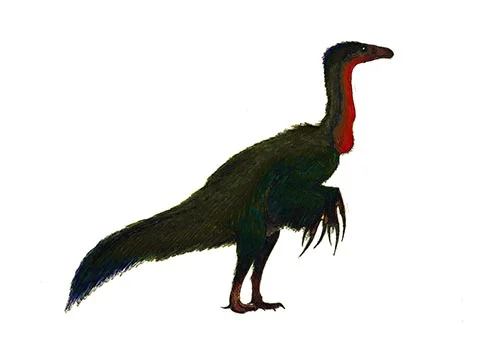Therizinosaurus (Scythe lizard)

Ther-ih-zine-oh-sore-us
Evgeny Maleev - 1954
Probably Herbivore
Estimated 10 meters long
Large Theropod
T. cheloniformis (type)
Mongolia
Late Cretaceous, 70-68 million years ago
Therizinosaurus Facts
Therizinosaurus, also known as the “scythe lizard,” is a genus of theropod dinosaur that lived during the Late Cretaceous period, around 70-68 million years ago. Its fossils have been found in what is now modern-day Mongolia.
Therizinosaurus was a bizarre-looking dinosaur, with long, curved claws that measured up to 3 feet (1 meter) in length. These claws were likely used for defense and possibly for reaching vegetation that was out of reach of its mouth. It had a small head with a toothless beak, and a long neck and tail. It was also one of the largest theropod dinosaurs, measuring up to 33 feet (10 meters) in length and weighing up to 5 tons.
The name Therizinosaurus means “scythe lizard” in reference to its long, curved claws, which were first thought to be a type of sickle. It was only later discovered that these claws were used for defense and reaching vegetation, not for hunting.
Therizinosaurus is part of a group of theropod dinosaurs called therizinosaurs, which were unusual among theropods in that they were herbivorous or omnivorous. Their teeth were small and serrated, and they had a broad, flat beak that was well-suited for cropping vegetation. This unique adaptation allowed them to exploit a niche that was different from most other theropod dinosaurs, which were carnivorous.
The discovery of Therizinosaurus fossils has provided important insights into the diversity and ecology of theropod dinosaurs during the Late Cretaceous period. Its unique adaptations for herbivory and its bizarre appearance have also made it a popular subject of scientific and popular interest.
In conclusion, Therizinosaurus is an important theropod dinosaur from Mongolia that lived during the Late Cretaceous period. Its long, curved claws and unique adaptations for herbivory have made it one of the most unusual and interesting dinosaurs. The discovery of Therizinosaurus fossils has contributed to our understanding of the diversity and ecology of theropod dinosaurs during the Late Cretaceous period, and has helped paleontologists better understand the evolutionary relationships between theropods and other groups of dinosaurs.



